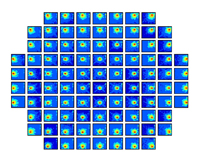PAF successfully 'snaps' sky shot

15 November 2011
CSIRO's new phased array feed (PAF), or 'radio camera', technology has been successfully demonstrated by taking its first detailed image of the sky. The image shows the raw on-sky port patterns from the PAF, which has been undergoing testing on a 12-metre antenna at CSIRO's Parkes Testbed Facility.
Data were taken at Parkes from September to November 2011, correlating each of 188 PAF ports (94 ports by two polarisations) on the 12-metre antenna with the central horn of the 20-cm multibeam receiver on the Parkes 64-metre radio telescope.
The 64-metre dish tracked radio galaxy Virgo A while the 12-metre dish executed a raster scan about Virgo A. This mapped out a 14 square degree patch of each PAF port pattern.
The resulting image shows a collage of 94 PAF port patterns of one polarisation that are each normalised to their peak. The colour scale is in decibels with approximately 55 dB range and each pattern is made from 40 1 MHz channels spread across 1.2 to 1.5 GHz.
"This latest round of testing demonstrates that one antenna's worth of ASKAP electronics is working and stable over a lengthy five-hour measurement. The ASKAP electronic system includes the phased array feed; analog downconversion; digital sampling, filtering and beamforming processors; and command and control computing," says Ant Schinckel, CSIRO's ASKAP Project Director.
"It has taken three years of cutting-edge research and development by CSIRO staff to reach this point. We're another notch along the way to demonstrating the feasibility of PAF technology for radio astronomy." CSIRO has been developing phased array feeds for our latest radio telescope, the Australian Square Kilometre Array Pathfinder, currently under construction in Western Australia.
PAF technology has been widely used in other applications such as radio broadcasting and radar systems, but has not been used before in radio astronomy. It offers increased survey speed and sensitivity, greatly increasing the scientific capability of the telescope over modern-day instruments.
"Creating this image has been the work of a huge team of people — the entire ASKAP team, from the PAF designers and builders through the data transport group to the digital backend team and software group — and is a great result for the project," says Ant.
The image was made on Wednesday 9 November 2011. It was shown to members of the ten science teams that will be the first to use ASKAP once the telescope becomes operational in 2013. The science teams, called ASKAP Science Survey Projects, held their annual meeting at CSIRO Astronomy and Space Science headquarters in Marsfield, NSW, 9–11 November 2011.
Back to Latest ASKAP News page.
